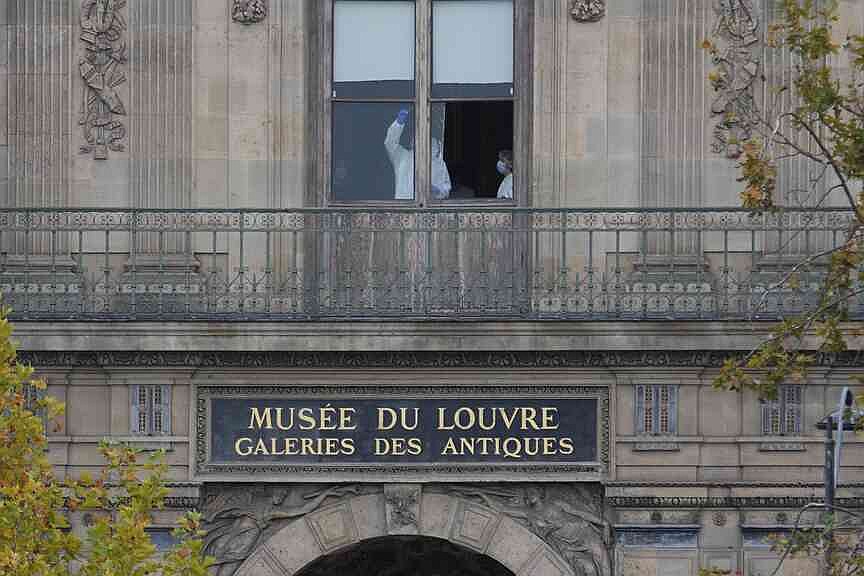Copyright Arkansas Online

PARIS -- In a minuteslong strike Sunday inside the world's most-visited museum, thieves rode a basket lift up the Louvre's facade, forced a window, smashed display cases and fled with priceless Napoleonic jewels, officials said. The daylight heist about 30 minutes after opening, with visitors already inside, was among the highest-profile museum thefts in living memory and comes as staff complained that crowding and thin staffing are straining security. The theft unfolded just 270 yards from the "Mona Lisa," in what Culture Minister Rachida Dati described as a professional operation. In their haste to leave, the thieves dropped a crown made for Empress Eugénie, the wife of France's 19th-century ruler Napoleon III, to wear during the Universal Exposition in Paris in 1855. It features eight gold eagles, 1,354 diamonds, 1,136 rose-cut diamonds and 56 emeralds. The Paris prosecutor's office said in a statement that a second jeweled item was also "lost or abandoned during the perpetrators' escape," but did not say what it was. Images from the scene showed confused tourists being steered out of the glass pyramid and adjoining courtyards as officers closed nearby streets along the Seine. A lift, which officials say the thieves brought and which was later removed, stood against the Seine-facing façade, their entry route, and, observers said, a revealing weakness: that such machinery could be brought to a palace-museum unchecked. THE HEIST Their faces concealed, two burglars rode a monte-meubles, which is a truck-mounted electric ladder that is a common sight on the streets of Paris and is used to ferry bulky furniture through the windows of apartments, up onto a second-floor balcony on the building's south side. Once there, they used grinders to break a window, setting off the security alarms, and burst inside the gilded Galerie d'Apollon, or Apollo Gallery, of the Louvre Museum, where a prized 23-item collection of royal jewels and crown diamonds, including the Regent, the Sancy and the Hortensia, is held in a succession of cases. There they smashed two cases, sounding more alarms, and snatched eight precious objects. The burglars went back down the ladder to a road shouldering the Seine and made their getaway with two waiting members of their team on motor scooters. Before fleeing the scene, the thieves tried to burn the basket of the monte-meubles that had carried them aloft, authorities said. In all, it took no more than seven minutes. No one was hurt, according to the French Ministry of Culture, though the Paris prosecutor's office said the staff had been threatened by the thieves. Alarms brought Louvre agents to the room, forcing the intruders to bolt, but the theft was already done. At the moment of the break-in, the museum was already full of visitors. Five museum staff members were either in or near the Apollo Gallery. Following the Louvre's security protocol, they contacted the police, "prioritizing the protection of people," according to a statement by the ministry. Eight objects were taken, according to officials: a sapphire diadem, necklace and single earring from a matching set linked to 19th-century French queens Marie-Amélie and Hortense; an emerald necklace and earrings from the matching set of Empress Marie-Louise, Napoleon Bonaparte's second wife; a reliquary brooch; Empress Eugénie's diadem; and her large corsage-bow brooch, a prized 19th-century imperial ensemble. 'SECURITY GAPS' "It's a major robbery," Interior Minister Laurent Nuñez said, noting that security measures at the Louvre had been strengthened in recent years and would be reinforced further as part of the museum's upcoming overhaul plan. Officials said security upgrades include new-generation cameras, perimeter detection and a new security control room. But critics say the measures come far too late. The Louvre closed for the rest of Sunday for the forensic investigation to begin as police sealed gates, cleared courtyards and shut nearby streets along the Seine. Daylight robberies during public hours are rare. Pulling one off inside the Louvre with visitors present ranks among Europe's most audacious in recent history, and at least since Dresden's Green Vault museum in 2019. It also collides with a deeper tension the Louvre has struggled to resolve: swelling crowds and stretched staff. The museum delayed opening during a June staff walkout over overcrowding and chronic understaffing. Unions say mass tourism leaves too few eyes on too many rooms and creates pressure points where construction zones, freight routes and visitor flows meet. Security around marquee works remains tight -- the "Mona Lisa" sits behind bulletproof glass in a climate-controlled case -- but Sunday's theft also underscored that protections are not uniformly as robust across the museum's more than 33,000 objects. The theft is a fresh embarrassment for a museum already under scrutiny. "How can they ride a lift to a window and take jewels in the middle of the day?" said Magali Cunel, a French teacher from near Lyon. "It's just unbelievable that a museum this famous can have such obvious security gaps." The Louvre has a long history of thefts and attempted robberies. The most famous came in 1911, when the "Mona Lisa" vanished from its frame, stolen by Vincenzo Peruggia and recovered two years later in Florence. Another notorious episode came in 1956, when a visitor hurled a stone at her world-famous smile, chipping paint near her left elbow and hastening the move to display the work behind protective glass. In 1976, three burglars broke into the Louvre at dawn, climbing up a metal scaffolding, smashing windows on the second floor and stealing a 19th-century diamond-studded sword that once belonged to King Charles X. And in 1990, a painting by Pierre-Auguste Renoir, "Portrait of a Seated Woman," was cut from its frame and stolen from a third-floor gallery. Today, the former royal palace holds a roll call of civilization: Leonardo's "Mona Lisa"; the armless serenity of the Venus de Milo; the Winged Victory of Samothrace, wind-lashed on the Daru staircase; the Code of Hammurabi's carved laws; Delacroix's "Liberty Leading the People"; Géricault's "The Raft of the Medusa." The objects -- from Mesopotamia, Egypt and the classical world to Europe's masters -- draw a daily tide of up to 30,000 visitors even as investigators now begin to sweep those gilded corridors for clues. THEFT MAKES POLITICAL WAVES The heist spilled instantly into politics. Far-right leader Jordan Bardella used it to attack President Emmanuel Macron, weakened at home and facing a fractured Parliament. "The Louvre is a global symbol of our culture," Bardella wrote on X. "This robbery, which allowed thieves to steal jewels from the French Crown, is an unbearable humiliation for our country. How far will the decay of the state go?" Macron said in a message on social media that the theft was "an attack on a heritage that we cherish because it is our History." Then he made a vow: "We will recover the works, and the perpetrators will be brought to justice. Everything is being done, everywhere, to achieve this." The Paris prosecutor's office said it had opened an investigation. The criticism lands as Macron touts a decadelong "Louvre New Renaissance" plan -- about $760 million -- to modernize infrastructure, ease crowding and give the "Mona Lisa" a dedicated gallery by 2031. For workers on the floor, the relief has felt slower than the pressure. Forensic teams are examining the site of the crime and adjoining access points while a full inventory is taken, authorities said. Officials have described the haul as of "inestimable" historical value. Recovery may prove difficult. "It's unlikely these jewels will ever be seen again," said Tobias Kormind, managing director of 77 Diamonds. "Professional crews often break down and re-cut large, recognizable stones to evade detection, effectively erasing their provenance." Key questions still unanswered are how many people took part in the theft and whether they had inside assistance, authorities said. According to French media, there were four perpetrators: two dressed as construction workers in yellow safety vests on the lift, and two each on a scooter. French authorities did not immediately comment on this. Investigators are reviewing CCTV from the Denon wing and the riverfront, inspecting the basket lift used to reach the gallery and interviewing staff who were on-site when the museum opened, authorities said. Information for this article was contributed by Thomas Adamson and Jill Lawless of The Associated Press and Catherine Porter and Aurelien Breeden of The New York Times.



